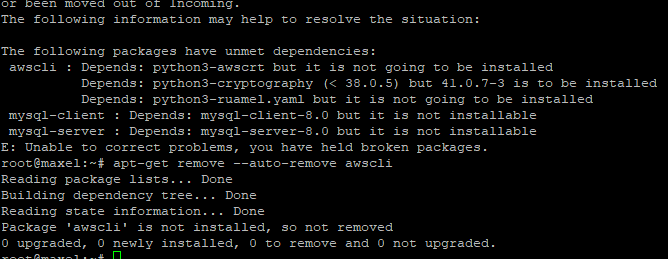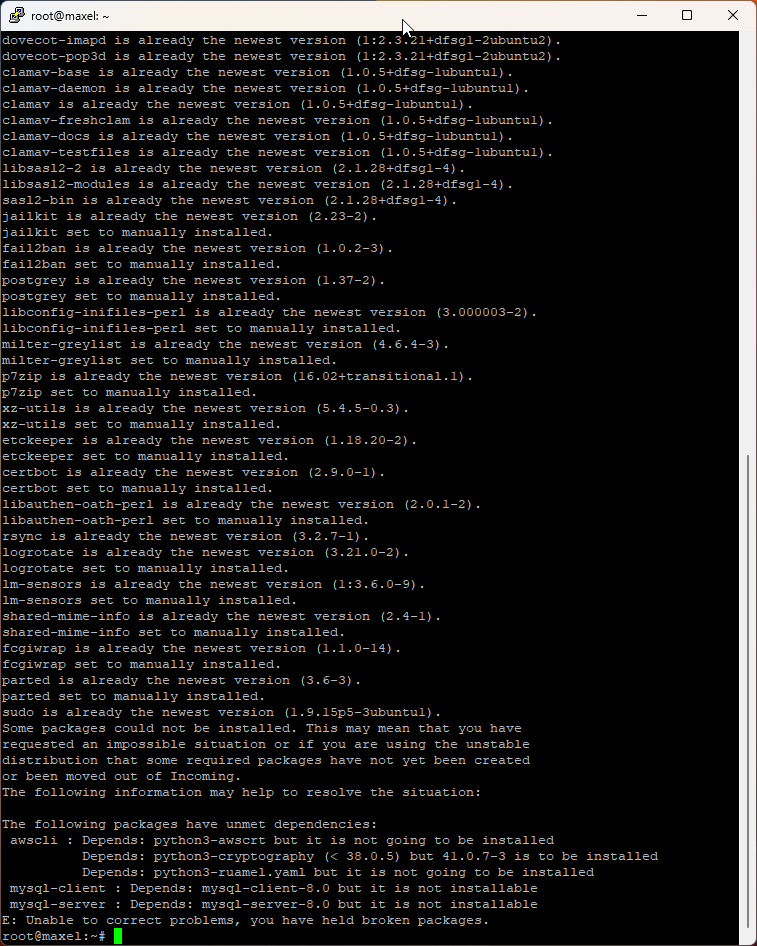You can remove awscli manually for now and re-try running slightly altered command provided before:
apt-cache depends virtualmin-lamp-stack | grep -E 'Depends|Recommends' | grep -v '<' | grep -vi 'maria' | cut -d ":" -f2 | xargs sudo apt-get install
I perform apt-get remove --auto-remove awscli and execute command again, but the output looks same.

Then exclude awscli from the previous command, like this:
apt-cache depends virtualmin-lamp-stack | grep -E 'Depends|Recommends' | grep -v '<' | grep -vi 'maria' | grep -vi 'awscli' | cut -d ":" -f2 | xargs sudo apt-get install
Also, don’t put screenshots, just copy/paste output and wrap it in triple ```.
Ohh sorry for that, here is the output again
Some packages could not be installed. This may mean that you have
requested an impossible situation or if you are using the unstable
distribution that some required packages have not yet been created
or been moved out of Incoming.
The following information may help to resolve the situation:
The following packages have unmet dependencies:
libevent-pthreads-2.1-7 : Depends: libevent-core-2.1-7 (= 2.1.12-stable-8ubuntu3) but 2.1.12-stable-9 is to be installed
E: Unable to correct problems, you have held broken packages.
Either way, I don’t think we can assist with that. Distro-upgrading to an unreleased version of Ubuntu isn’t something we support or fix.
I suggest using the Virtualmin CLI to back up all existing virtual servers, then spin up a new instance and migrate. This approach would be much cleaner and quicker. Personally, I would choose Debian 12 if I had to reinstall today.
How to generate and transfer backups
On your current server, create a backup directory and back up all virtual servers using these commands:
mkdir /root/backups
virtualmin backup-domain --dest /root/backups/ --all-domains --all-features --newformat --all-virtualmin
Transfer the backups to your new server with secure copy:
scp -r /root/backups root@new-server.com:/root/
Restore domains
Run these commands, and be patient, it can take a while:
virtualmin restore-domain --source /root/backups/virtualmin.tar.gz --all-virtualmin
virtualmin restore-domain --source /root/backups/ --all-domains --all-features
This process restores your Virtualmin settings first, then all your virtual servers.
I got this
Copying Logrotate configuration ..
.. no log rotation configuration found for /var/log/virtualmin/domain.com_access_log
Saving Virtualmin configuration ..
.. done
Saving templates and plans ..
.. done
Saving email templates ..
.. done
Saving custom fields, links, categories and shells ..
.. done
Saving custom script installers ..
.. done
Saving scheduled backups ..
.. done
Saving DKIM settings ..
.. not installed
Saving greylisting settings ..
.. done
Save mail rate limiting configuration ..
.. not installed
Saving mail server configuration ..
.. done
.. done
Backup failed!
If you have backups taken before the distro-upgrade, you should use them now. I hope you did, right? If not, you can still spin up a new instance and move the files manually. It’s not a big deal, but it will take more time.
I have only backup from configuration files and mysql databases, but no full backup ![]()
Do you think if i try to downgrade ubuntu to 22 version the problem will be fixed?
btw i send you pm ![]()
I have no clue. I don’t think anybody does actually.
Sorry, we’ve seen your message and would be glad to help, but we simply don’t have the time! If you’re considering recovering your system, you might want to hire a freelance server administrator. One doesn’t need very high qualifications to fix all this or migrate you to a new system.
However, again, I’d suggest letting go of this system and just migrating to Debian 12!
We don’t use this, AFAIK (Perl might, but I don’t think we use threads anywhere, either), so you can skip this one, too, probably. Or uninstall and reinstall this package so it gets updated.
But, also this indicates problems beyond just Virtualmin/Webmin. You have a lot of broken packages, it seems…I’m not sure your OS upgrade went well.
And, I have to emphatically beg everyone to please keep good backups! Especially when upgrading your OS!
can you help me to solve this logrotation error so i can procceed with doing backups.
Copying Logrotate configuration ..
.. no log rotation configuration found for /var/log/virtualmin/domain.com_access_log
Saving Virtualmin configuration ..
.. done
Saving templates and plans ..
.. done
Saving email templates ..
.. done
Saving custom fields, links, categories and shells ..
.. done
Saving custom script installers ..
.. done
Saving scheduled backups ..
.. done
Saving DKIM settings ..
.. not installed
Saving greylisting settings ..
.. done
Save mail rate limiting configuration ..
.. not installed
Saving mail server configuration ..
.. done
.. done
You could use --except-feature logrotate flag to skip on log rotation feature.
One company I was at used off site tape backups. Monday morning we came in, chose a tape, and checked a random file before sending it off with the courier. So, yeah, backup but also verify.
i just bough pro version and install debian 12.
using apt-get install webmin --install-recommends it install and i can access via port 10000.
but what is the default root password to enter it?
Please open a new thread for a new question.
But, there is no default. It is what it was before you installed webmin.
EDIT: Oh wait. No default root on Ubuntu? Try the user you set up.
I install fresh Debian and Pro webmin, i loggin to server with ssh but the script does not asking me for any password. Now on port 10000 need username and password. ![]()
Is this at a provider? If you can get in via ssh you should have sudo. But, this is off topic for this thread.
